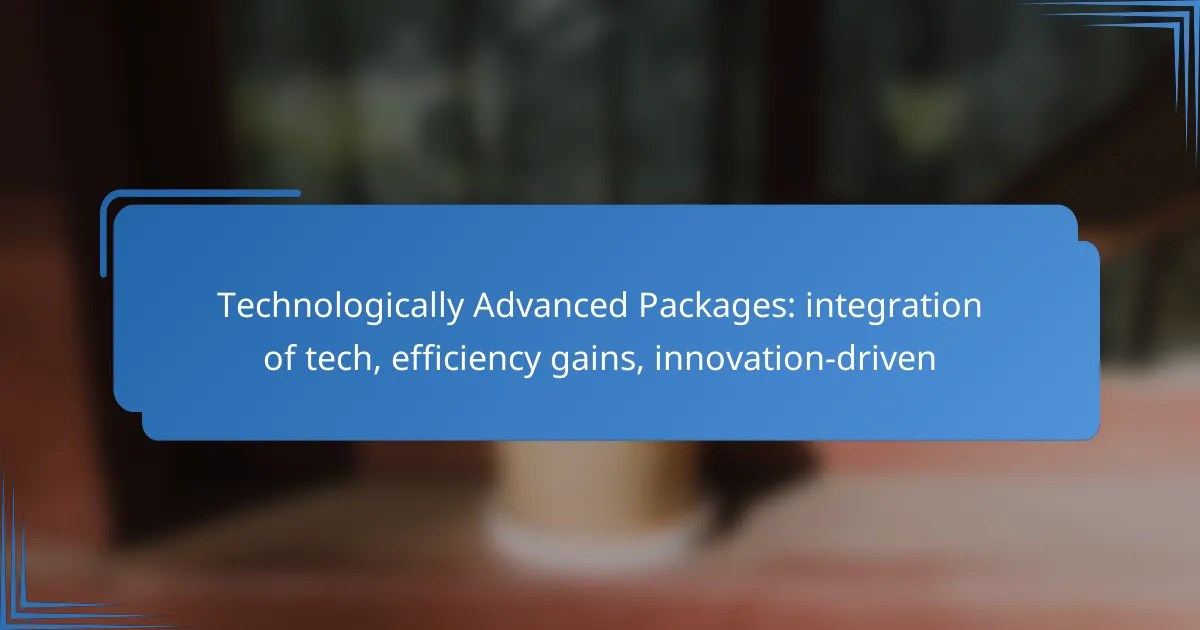Technologically advanced packages are revolutionizing the logistics landscape by integrating innovative features that enhance efficiency and reduce costs. By leveraging automation, smart materials, and data analytics, these packages optimize supply chain processes while promoting sustainability and consumer engagement through advancements like the Internet of Things and augmented reality.
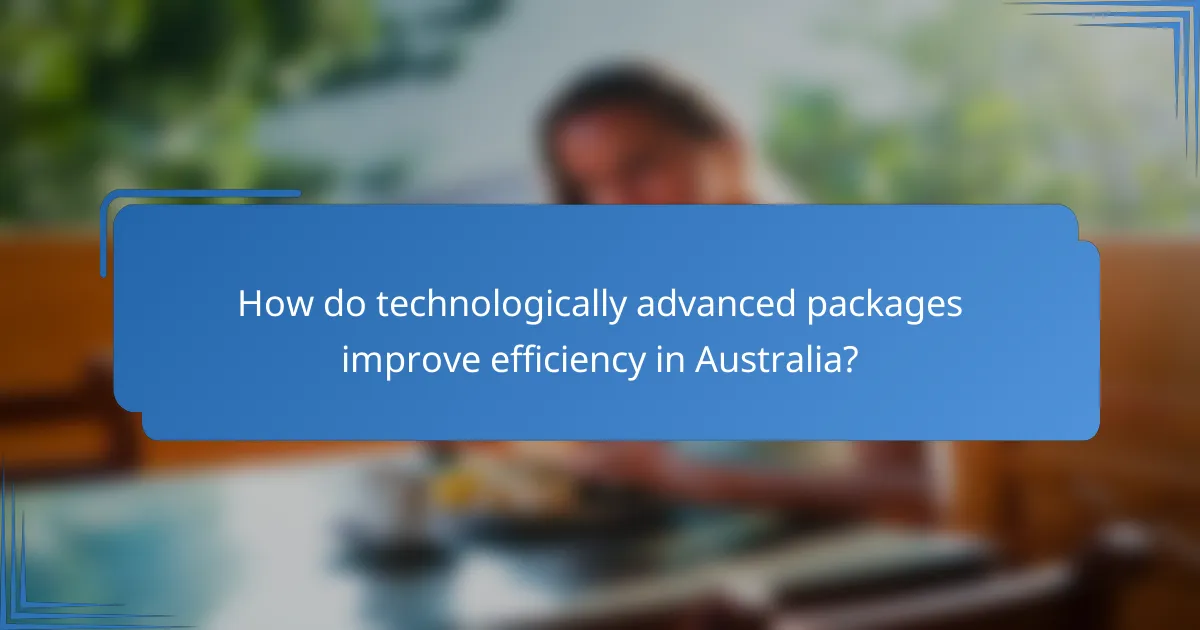
How do technologically advanced packages improve efficiency in Australia?
Technologically advanced packages enhance efficiency in Australia by integrating innovative features that streamline logistics and reduce operational costs. These packages utilize automation, smart materials, and data analytics to optimize supply chain processes and improve overall productivity.
Automated tracking systems
Automated tracking systems allow businesses to monitor the location and status of packages in real-time. By using GPS and RFID technology, companies can reduce delays and improve delivery accuracy, leading to higher customer satisfaction.
In Australia, implementing these systems can significantly cut down on manual tracking efforts, which are often prone to errors. Businesses should consider investing in software that integrates seamlessly with existing logistics platforms to maximize benefits.
Smart packaging materials
Smart packaging materials are designed to interact with their environment, providing valuable information about the product inside. These materials can include sensors that monitor temperature, humidity, and even tampering, ensuring that products remain in optimal condition during transit.
For Australian businesses, using smart packaging can lead to reduced waste and lower costs associated with product spoilage. Companies should evaluate the cost-effectiveness of these materials based on their specific product requirements and shipping conditions.
Real-time data analytics
Real-time data analytics enables businesses to make informed decisions based on current operational data. By analyzing trends and performance metrics, companies can identify inefficiencies and adjust their strategies accordingly.
In the Australian market, leveraging data analytics can lead to significant improvements in inventory management and demand forecasting. Businesses should focus on integrating analytics tools that provide actionable insights to enhance their supply chain efficiency.

What innovations are driving packaging technology?
Innovations in packaging technology are primarily driven by advancements in the Internet of Things (IoT), the use of biodegradable materials, and the integration of augmented reality features. These developments enhance efficiency, sustainability, and consumer engagement in packaging solutions.
IoT integration in packaging
IoT integration in packaging allows for real-time tracking and monitoring of products throughout the supply chain. By embedding sensors and RFID tags, companies can collect data on temperature, humidity, and location, ensuring optimal conditions and reducing spoilage.
This technology not only improves inventory management but also enhances customer experience by providing transparency. For example, consumers can access information about the product’s journey from production to delivery, fostering trust and engagement.
Biodegradable materials
Biodegradable materials are becoming increasingly popular as companies seek to reduce their environmental impact. These materials, which can break down naturally over time, offer a sustainable alternative to traditional plastics, aligning with growing consumer demand for eco-friendly products.
Common biodegradable options include plant-based plastics, paper, and compostable films. When selecting materials, consider certifications such as ASTM D6400 or EN 13432, which ensure compliance with composting standards.
Augmented reality features
Augmented reality (AR) features in packaging enhance consumer interaction by providing immersive experiences. Through AR apps, users can scan packaging to access additional information, promotional content, or interactive elements that engage them with the brand.
For instance, a beverage company might use AR to show the drink’s origin story or suggest cocktail recipes. This innovative approach not only differentiates products on the shelf but also builds a stronger connection with consumers, driving brand loyalty.

Which companies lead in advanced packaging solutions?
Several companies are at the forefront of advanced packaging solutions, focusing on integrating technology to enhance efficiency and drive innovation. Notable leaders include Amcor, Sustainable Packaging Industries, and Smurfit Kappa, each contributing unique approaches to modern packaging challenges.
Amcor
Amcor is a global leader in packaging solutions, known for its commitment to sustainability and innovation. The company integrates advanced technologies such as smart packaging and recyclable materials to improve product shelf life and reduce environmental impact.
One of Amcor’s key offerings is its use of digital printing, which allows for customization and reduced waste. This technology enables brands to create targeted packaging that resonates with consumers while maintaining efficiency in production.
Sustainable Packaging Industries
Sustainable Packaging Industries specializes in eco-friendly packaging solutions that prioritize environmental responsibility. The company focuses on using renewable materials and minimizing carbon footprints throughout the packaging lifecycle.
By adopting practices such as compostable packaging and innovative recycling processes, Sustainable Packaging Industries helps businesses meet regulatory standards and consumer demand for sustainable products. Their solutions often lead to cost savings in waste management and improved brand loyalty.
Smurfit Kappa
Smurfit Kappa is a leading provider of paper-based packaging solutions, emphasizing innovation and efficiency. The company utilizes advanced technologies like automation and data analytics to optimize production processes and reduce waste.
With a strong focus on circular economy principles, Smurfit Kappa designs packaging that is not only functional but also easily recyclable. Their commitment to sustainability is reflected in their extensive range of products that cater to various industries, helping clients achieve their environmental goals while maintaining cost-effectiveness.
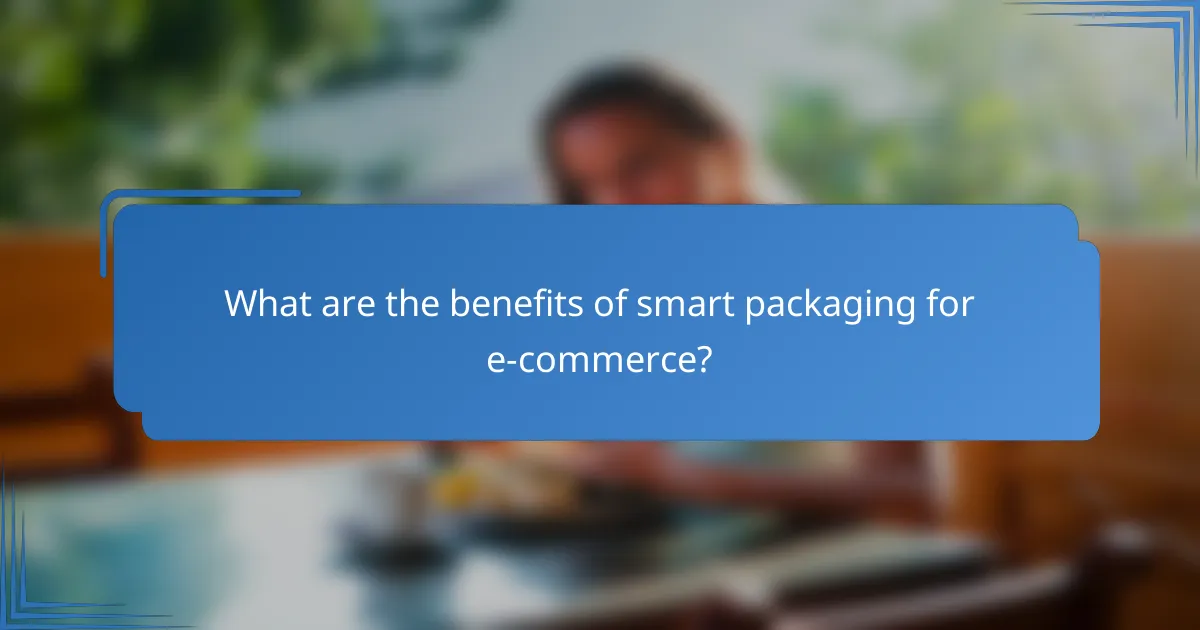
What are the benefits of smart packaging for e-commerce?
Smart packaging offers significant advantages for e-commerce by enhancing efficiency, reducing costs, and improving customer satisfaction. By integrating technology into packaging, businesses can streamline operations and provide a better experience for consumers.
Enhanced customer experience
Smart packaging enhances the customer experience by providing real-time tracking and personalized interactions. For instance, QR codes can be scanned for instant access to product information, promotional offers, or usage tips, making the purchase more engaging.
Additionally, features like tamper-evident seals and freshness indicators build trust and assurance in product quality. This transparency can lead to increased customer loyalty and repeat purchases.
Reduced shipping costs
Integrating technology in packaging can significantly lower shipping costs by optimizing package size and weight. Smart packaging solutions often use lightweight materials that maintain durability, reducing overall shipping expenses.
Moreover, smart systems can analyze shipping routes and package dimensions to minimize waste and improve logistics efficiency. This can lead to savings of up to 20% in shipping costs for businesses that adopt these technologies.
Improved inventory management
Smart packaging aids in inventory management by providing real-time data on stock levels and product movement. RFID tags and sensors can track items throughout the supply chain, ensuring accurate inventory counts and reducing the risk of stockouts or overstock situations.
By implementing these technologies, businesses can improve their forecasting accuracy and streamline restocking processes, ultimately leading to better cash flow and reduced holding costs.
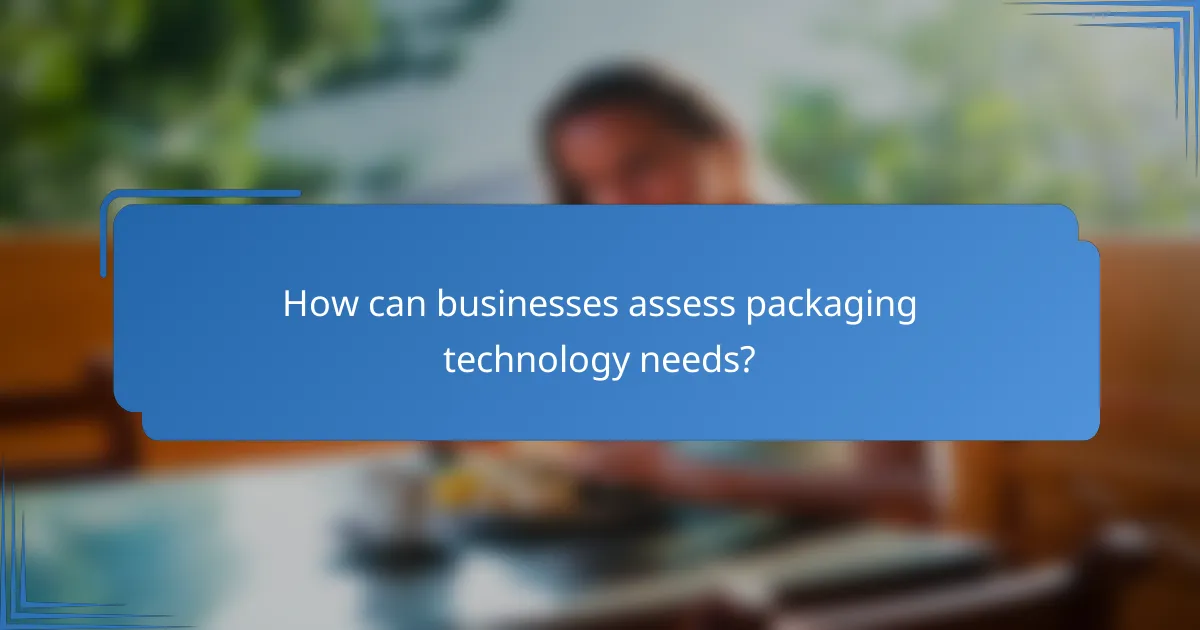
How can businesses assess packaging technology needs?
Businesses can assess their packaging technology needs by evaluating their current processes, identifying inefficiencies, and determining how technology can enhance productivity and reduce costs. This assessment should consider both immediate requirements and future growth potential.
Cost-benefit analysis
A cost-benefit analysis helps businesses weigh the financial implications of adopting new packaging technologies. This involves calculating the initial investment against potential savings from improved efficiency and reduced waste.
Key factors to consider include equipment costs, maintenance expenses, and potential increases in production speed. For example, if a new automated packaging system costs around $50,000 but is expected to save $15,000 annually in labor costs, the payback period would be approximately three to four years.
Market demand evaluation
Evaluating market demand is crucial for understanding how packaging technology can meet customer expectations and industry trends. Businesses should analyze consumer preferences, competitor offerings, and regulatory requirements that may influence packaging choices.
For instance, if there is a growing demand for sustainable packaging solutions, investing in biodegradable materials or smart packaging technologies could align with market trends and enhance brand reputation. Surveys and market research reports can provide valuable insights into these evolving demands.
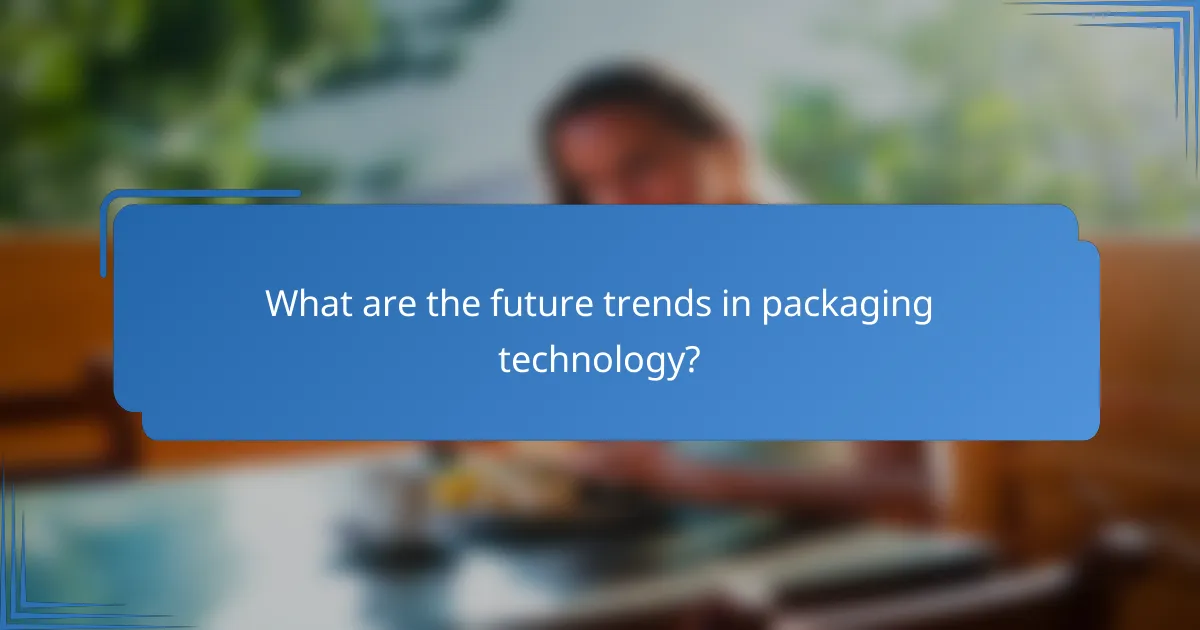
What are the future trends in packaging technology?
The future of packaging technology is characterized by advancements that enhance efficiency, customization, and sustainability. Key trends include increased automation, personalized packaging solutions, and advanced sustainability practices that cater to evolving consumer demands and environmental considerations.
Increased automation
Increased automation in packaging technology streamlines production processes, reducing labor costs and minimizing human error. Automated systems can handle tasks such as filling, sealing, and labeling at speeds previously unattainable, often achieving efficiency gains of 20-50% in some operations.
Investing in automation tools, such as robotic arms and conveyor systems, can significantly improve throughput. Companies should assess their production needs and consider scalable solutions that can adapt to changing market demands.
Personalized packaging solutions
Personalized packaging solutions allow brands to tailor their products to individual consumer preferences, enhancing customer engagement. This trend is driven by advancements in digital printing technology, which enables short runs of customized packaging without significant cost increases.
Brands can utilize data analytics to understand consumer behavior and preferences, creating packaging that resonates with target audiences. Implementing personalized elements, such as names or unique designs, can increase brand loyalty and drive sales.
Advanced sustainability practices
Advanced sustainability practices in packaging focus on reducing environmental impact through innovative materials and processes. This includes the use of biodegradable materials, recyclable designs, and reduced packaging sizes to minimize waste.
Companies should consider adopting circular economy principles, where packaging is designed for reuse or recycling. Staying informed about local regulations regarding packaging waste can help businesses align their practices with compliance requirements and consumer expectations.
